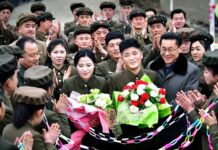[imText1]Lee Hwal, whose death was announced by the Chosun Central News Agency on the 3rd, is a living history in the North Korean Air Force.
The news agency reported on this day that the National Chairman Kim Jong Il expressed deep grief at the death of Lieutenant-General Lee Hwal, who was the Honorary Commentator at the “Fatherland Freedom War (Korean War) Commemorative Museum,” and sent flowers to the mortuary where his body lies.
Lee Hwal, whose place of origin is Yumju, North Pyongan, graduated from Japan’s Nagoya Aviation Corporal School and is one of the Japanese Air Force aces who put in over 2,000 hours of flight time.
Many North Korean experts consider that it is highly feasible that Lee Hwal’s experience participating in the Pacific War as a Japanese Air force would be distorted into civil aviation work experience, because his contribution to the establishment and the development of the North Korean Air Force was significant.
North Korean movie, “Red Wings,” which was modeled after Lee Hwal, increase the cogency of such an analysis.
The movie starts out with the story of a teenager, who has lost his fatherland by the Japanese Empire, graduating from an aviation school in Japan and becoming a top pilot. Even after becoming a top aviator, the teenager, who has fallen into the fate of inescapable death by becoming a Kamikaze of the Japanese army, encounters the new fatherland of Kim Il Sung, realizes its preciousness, and kills himself, along with his plane, for the fatherland.
Rich role of North Korean Air Force’s Midwife
North Korea evaluates that Lee Hwal, when imperial Japan was defeated in 1945, made a large contribution to preventing the destruction of the war planes and Shinuiju Airport, which Japan had built, by gathering the Chosun (North Korea) pilots whose were originally a part of the Japanese army.
Lee Hwal, by acting as the admiral of the Shinuiju Aviation Unit which had become the parent of the North Korean Air Force, led the establishment of the Air Force, along with 20 junior aviators who had served in the Japanese army.
Among these were Kang Chi Woo, who acted as the Technical Division Commander of the Air Force in the later days of the Korean War, Kim Gi Ok (Captain of Air Force Unit No. 1), Kim Han Wook (Captain of Air Force Unit No. 2), etc. All of them had been pilots in the Japanese army.
Lee Hwal fixed the `95 Japanese training plane and operated it to Chongjin, Jeongju, Pyongyang, and Shinuiju and taught aviation skills to new entrants of the air force.
North Korea established an aviation division with fighter planes, such as the IL-10 and Yak-9, which was received from the evacuating Soviet Union in October 1948, and with the fighter planes received from Kim Il Sung’s visit to Soviet Union in 1949. Wang Yun became the original Aviation Division Chief and Lee Hwal was assigned as the Vice-Chief of the Aviation Division. Wang Yun had been recommended by the Soviet army.
Lee Hwal, during the Korean War, acted as the Aviation Division Chief and the Air Force Deputy Commander, advanced to Air Force Commander when his contribution was acknowledged, and even was granted the title of “Hero of the Republic.”
What has been observed is that North Korean regime did not purge Lee Hwal and the other 20 pilots from the Japanese army, but received them into the North Korean Air Force and practically, established the air force through them.
Lee Hwal is a representative figure who provides evidence to the contrary to the position that North Korea has completely liquidated the pro-Japanese party.
It can be seen that at the time of the establishment, despite the fact that the battle experience of the land army was obscure, that guerrillas, who fought against Japanese army during the colonial period, were appointed to important posts without too great of a repercussion, but the members of the air force, without skills, could not be utilized as leaders, so Lee Hwal and the other civilians of the Japanese army were warmly received as pilots.
Kim Il Sung apportioned the manpower of the air force, which was considerably weaker than the land army and the navy, with Japanese-army pilots and technicians. Kim Il Sung showed significantly high interest in the establishment of the air force, by even stepping up as the honorary chair while organizing the Korean Aviation Committee.
Lee Hwal, at one point, was caught for the element of his birth, so was demoted from air force commander to a laborer to the Kadam Electrical and Technical Factory in Hamheung, South Hamkyung for 10 years.
Some days later, Kim Il Sung called Lee Hwal back to Pyongyang, saying “Lee Hwal was ensnared by secession faction.” Lee put on the army attire which he had taken off and his rank was appointed as the People’s Lieutenant General, so he began to work as a lecturer at the Fatherland Freedom War Commemorative Museum.
On one hand, North Korea evaluated Lee Hwal as an admirable person, who did not go to South Korea even when it tried to persuade him with the position of Air force Commander, and produced the movie, “Red Wings,” which contains some part of his life story.

















